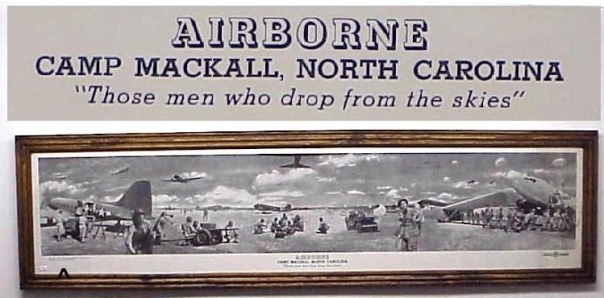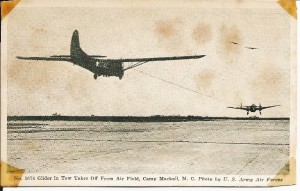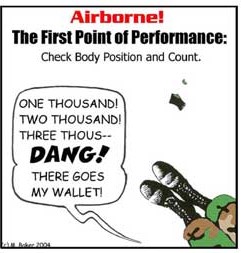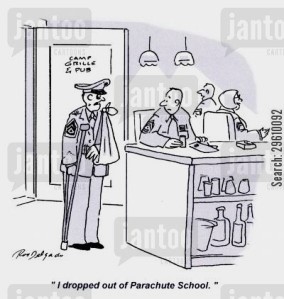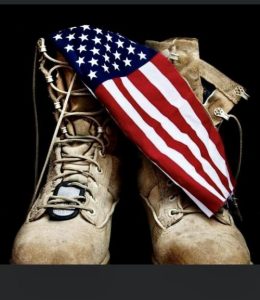Blog Archives
Camp MacKall & the 11th Airborne Division are born
The original idea for an American airborne came from Gen. Billy Mitchell in 1918. His commander, Gen. Pershing agreed, but once the WWI Armistice was signed, the plan was terminated. In the late 1920’s, Germany began training parachute units and in the 1930’s, and they led the world in gliders. Russia created the Air Landing Corps in 1935. Japan started in 1940 with German instructors. The U.S. did not take note until Germany was successful on Crete in 1941.
The American tradition was born when 48 men jumped at Ft. Benning on Aug. 16, 1940, where Private Eberhard, promised to yell to his buddies below, was the first to shout out “Geronimo”. General William Lee is considered the “Father of the Airborne.” My father, Everett Smith or “Smitty” (as you’ll get to know him), did not care for heights or jumping, so I asked him – “Why volunteer?” He shrugged and said, “They pay you more in the paratroopers.” Smitty had a dry sense of humor which you will see more of in the letters he wrote to his mother in future posts. He did however accept his boot camp, sharp shooting, glider & parachute training as a way of learning new things he would otherwise have never experienced. Since he was 27 and much older than other recruits, he was often referred to by the nickname of “Pops.”
The 11th Airborne Division was formed on Feb. 25, 1943 and their conditioning was so severe that most of the men felt combat would be a breeze. They were the first A/B division formed from scratch, so instead of following the manuals – they were writing their own. The camp was under construction 24/7 and they took classes sitting in folding chairs and easels were used for map reading, first-aid, weapons, foxholes, rules of land warfare, communications, field fortifications, and so on. Between May and June one battalion at a time went to Fort Benning for jump school.
When the time came for Stage A of jump school, it was scratched since the men were already as fit as possible. Stage B, was learning to tumble, equipment knowledge, sliding down a 30′ cable and packing a parachute. In Stage C, they used a 250-foot tower, forerunner to the one at Coney Island, to simulate a jump. Stage D, they earned their jump wings and boots. In June, the units began training in every circumstance that might arise in combat.
DOWN FROM HEAVEN, COMES THE 11 [airborne that is]
The gliders used were WACO CG 4A, boxlike contraptions with wings. The skeleton was small gauge steel covered with canvas; a wingspan of 84 feet, length of 49 feet and carried 3,700 pounds = two pilots and 13 fully loaded soldiers or a jeep and 6 men. The casualty list developing these appeared endless to the men. Smitty could not listen to “Taps” without tearing up, even in his later years.
21 June, the division entered the unit training program. During July, all units went on 10-day bivouacs and to Fort Bragg. Glider formal training occurred at Maxton Air Base.
In July, in Sicily, Operation Husky went terribly awry, due to the weather conditions – 3,800 paratroopers were separated from their gliders and each other. The casualty rate was exorbitant. This created serious doubts about the practicality of a division size airborne. Proof would rest on the shoulders of the 11th and their commander, Gen. Joseph May Swing. A demonstration called the “Pea Patch Show” was displayed for Sec. of War, Stimson. He gave Swing a positive review, but it did not convince Gen. Marshall or McNair. The fate of the Airborne Command rested on the upcoming Knollwood Maneuvers.
********** ********** **********
Smitty’s hometown of Broad Channel sent out a free issue of their newspaper, “The Banner”, to every hometown soldier and this became another source of back front info, along with news from his mother and friends: the Historical Society shows Smitty and events of the town’s history.
News that Smitty got from home at this point: Broad Channel was getting their own air raid siren. (Broad Channel is one-mile long and about 4-blocks wide). His neighbors, the Hausmans, heard from their POW son in the Philippines. And – his divorce papers were final, Smitty was single again.
#############################################################################
Military Humor –
#############################################################################
Farewell Salutes –
Robert W. Cash – MN; US Army Air Corps, WWII, PTO, Pvt. # 17025678, 28th Material Squadron/20th Air Base Group, POW, DWC (Cabanatuan Camp # 1, Luzon)
Michael J. Chvilicek – Havre, MT; US Navy, USS Midway, Independence & Ranger, Chief Mineman (Ret. 24 y.)
William Goines – Lockland, OH, US Navy, Vietnam, SEAL, Master Chief (Ret. 32 y.), Bronze Star
Mayburn L. Hudson – Lynchburg, VA; US Army, WWII, ETO, Sgt., Co F/2/330/83rd Infantry Division, KIA (“The Citadel”, FRA)
Edward L. Johnson – Baltimore, MD; USMC, Cpl., USS Midway
Casmir P. Lobacz – Kenosha, WI; US Army, WWII, ETO, SSgt., Co E/11/5th Infantry Division, KIA (Ancy-sur-Moselle, FRA)
Willie H. Mays Jr. – Westfield, AL; US Army, military baseball player / MLB
Carl E. Patterson – Washington D.C.; US Army, pilot / US Air Force, Audit Agency / Vietnam, Colonel (Ret. 30 y.)
Donald “Mo” E. Richmond – Ottumwa, IA; US Navy, USS Pomfret, Alamo, Cavalier, Holmes County, Waddle, Higbee & Midway, Chief Petty Officer (Ret. 22 y.)
Robert J. Wilson – Penn Yan, NY; US Army, EOD Specialist (explosives)
#############################################################################
 #############################################################################
#############################################################################
